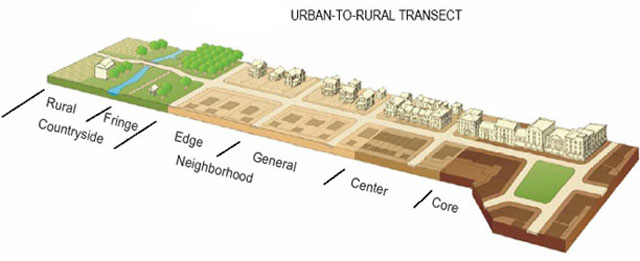Form-based planning ‘OS’ key to knowledge economy


No graph better explains the evolution of the economy and placemaking better than this one. Note how the emergence of the knowledge economy is resulting in the demand for places that share the same values with walkable, mixed-use neighborhoods, similar to the times before the industrial, mass production era.
Now, we all know the modern computer operating systems for workplace productivity lie in Linux, Mac OS and Windows, and increasingly in iOS and Android. So what’s the operating system for our literal physical workplaces and surrounding built environment? One such leading operating system for modern urban planning is known as form-based codes.
Form-based codes are an “open source form-based unified land development ordinance designed to create walkable neighborhoods across the full spectrum of human settlement, from the most rural to the most urban, often incorporating a transect (see image above) of character and intensity within each. It folds zoning, subdivision regulations, urban design, and basic architectural standards into one compact document.”
What distinguishes form-based codes from late 20th Century planning approaches is that it’s not use-based, but form-based as its name implies. Industrial era planning codes planned cities by separation of land uses – industrial district here, housing subdivisions there, retail shopping malls here, etc. Ironically, you could easily tell the use by the form (strip malls, office parks, shopping malls, subdivisions). However, the economy and our culture is ever changing and evolving, so what may be appropriate for retail yesterday may be better suited for residential today. Unfortunately, under a use-based code, you couldn’t easily convert an empty big-box shell into desirable apartments.
With a form-based code, not only is it simple, but you don’t have to redevelop anything. Residents and businesses switch uses back and forth all the time without changing the buildings in form-based neighborhoods, which by the way, were the norm prior to 1930 – see the building types in the ‘core’ on the right side of the image above.
What’s on the horizon? While form-based codes may be the equivalent of the Linux/Mac/Windows era of modern knowledge era operating systems, it’s not quite as fresh as the iOS/Android generation. That’s when you’ll start to see a more progressive version of form-based codes addressing pedestrian-only streets and piazzas, which aren’t accommodated in the present in many form-based codes.
Learn more about form-based codes at the Form-Based Code Institute.

Leave a Reply